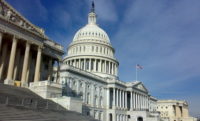Design and construction firms that focus on federal work now know how much funding many key government programs will receive through next fall, thanks to a massive, newly enacted fiscal 2012 omnibus spending package.
But as industry officials examine the results for construction accounts scattered through the $915-billion omnibus, they mostly see bad news: Most programs were cut from 2011 levels, though a few line-items did score increases.
The new package includes funding for the Depts. of Defense, Energy and Veterans Affairs--among others--as well as such agencies as the General Services Administration and Environmental Protection Agency.
Sean O’Neill, Associated General Contractors of America congressional relations director for infrastructure advancement, says, “We are seeing some areas where the appropriators…are recognizing the importance of investing in our federal construction accounts and other areas where they are not.”
President Obama signed the measure into law on Dec. 23. Final congressional approval of the package came on Dec. 17, when the Senate passed the bill on a 67-32 vote. The House cleared the measure one day earlier.
On Dec. 17 Obama had signed a short continuing resolution that kept the agencies in operation through Dec. 23. Previous extensions expired on Dec. 16 and on Dec. 17.
The Depts. of Transportation, Housing and Urban Development, Commerce, Justice and Agriculture aren't included in the omnibus. A separate bill funding their programs through the end of fiscal 2012 was enacted on Nov. 18.
Given the continued squeeze on overall federal discretionary spending, it’s no surprise that lawmakers sliced many construction accounts in the new omnibus bill.
Most of the reductions are relatively small, in percentage terms, but they amount to tens of millions of dollars worth of cuts and foregone work for construction firms still battling for new business wherever they can find it.
Among the programs hit with cuts is EPA water infrastructure, which appropriators pared 4%, to $3.6 billion.
Within that total, aid for Clean Water State Revolving Funds (SRFs), which help finance wastewater-treatment facilities, was sliced 4%. Drinking water SRFs were down 5%.




















